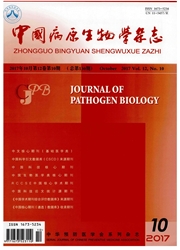

 中文摘要:
中文摘要:
目的探讨NK细胞在TLR9激动剂CpG抑制肝期约氏疟原虫发育中的作用。方法小鼠尾静脉注射NK细胞拮抗剂Anti-Asialo-GM1 40μg后48h给予1 000个约氏疟原虫BY265株子孢子攻击,采用Real-time PCR检测肝脏虫荷并血检疟原虫,分析CpG在NK细胞阻断小鼠中对肝期约氏疟原虫发育的影响。结果 NK细胞阻断后GM1+CpG组小鼠肝脏虫荷与CpG组相比显著增加(t=3.539,P〈0.01),与PBS对照组相比显著降低(t=3.658,P〈0.01);GM1组与PBS对照组比较差异无统计学意义(t=1.768,P〉0.05)。CpG组未出现原虫血症,GM1+CpG组出现原虫血症,但出现时间和PBS对照组相比推迟且原虫血症的峰值降低,小鼠逐渐自愈。PBS组和GM1组小鼠从感染第13d开始出现死亡,第15d全部死亡。结论 NK细胞参与对肝期疟原虫的杀伤过程,TLR9激动剂CpG依赖NK细胞杀伤肝期疟原虫。
 英文摘要:
英文摘要:
Objective To investigate the role of NK cells in TLR9 agonist CpG induced inhibition of Plasmodium yoelii development.Methods NK cells were depleted by intravenous injection of Anti-Asialo-GM1.Forty eight hours later,mice were challenged with 1 000 P.yoelii sporozoites.Real-time PCR was used to detect the liver parasite load 42 hours post-challenge.Blood smears were used to check for parasitemia.Results Mice treated with CpG after NK depletion had a higher parasite load than CpG-treated mice(t=3.539,P〈0.01) but a lower load than control mice treated with PBS(t=3.658,P〈0.01).No significant differences were noted between mice treated with PBS or GM1(t=1.768,P〉0.05).CpG-treated mice did not develop a blood-stage infection.Mice treated with GM1+CpG had a delayed blood-stage infection and low peak of parasitemia compared to PBS-treated mice.Moreover,mice treated with PBS or GM1 began to die on day 13 post-challenge and all had died by day 15 while mice treated with GM1+CpG recovered.Conclusion CpG-induced inhibition of liver-stage parasite development is NK cell-dependent.
 同期刊论文项目
同期刊论文项目
 同项目期刊论文
同项目期刊论文
 期刊信息
期刊信息
